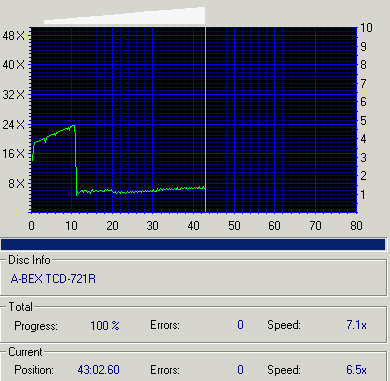YAMAHA CRW-F1E CD-RW
4. Error Correction Tests
Error Correction Tests
In the following tests we examine the error correction capabilities of YAMAHA CRW-F1. We use the built-in Nero CD Speed CD Quality test and CDVD Benchmark v1.21 software. The reference test media come from ABEX and Philips.
- ABEX TCD-714R
This test disc has been produced for measuring and adjusting the tracking servo characteristics of the drive, against the eccentricity of compact disc. The fundamental characteristics of this disc other than on eccentricity are compatible with the standards in "Red Booklet". The test examines the ability to trace eccentricity of the compact disc player.
In reference to a zero eccentricity disc, we check the following phenomena:
a. There is skipping of sound tracks
b. Requires excess time to locate or cannot locate the starting point of the
tune.
c. Mechanical noise is heard from the CD player
d. Requires excess time to read or cannot read the TOC information
e. The spindle motor runs wild
Physical characteristics of disc:
- Eccentricity: 280 micro meters
- Daviation: 3 micro meters


Our tests did not show any of the above negative behaviours from the YAMAHA CRW-F1.
- ABEX TCD-721R
This test disc is produced with the objective of measuring and adjusting the CD player's tracking servo characteristics and error correction ability against scratches on the disc. Artificial scratches with lengths from 1.8 mm to 3.0 mm are found on the disc. The phenomenon that may occur during playback of the disc contents are:
a. Noise is created
b. The sound skips
c. The same section is repeatedly played
d. Start of the tune cannot be detected
e. The spindle motor rotates erratically (reverse rotation, change
in revolution, e.t.c)


Nero CD Speed showed that the drive slowed down the reading process when the size of the errors on the disc became large enough. However, no errors were occurred.
- ABEX TCD-726
This disc is produced for measurement and adjustment of error ability and tracking / focusing servo characteristics of a CD player against defects included in some discs. Three kind of defects, interruption, black dots and fingerprints are prepared in this disc. The interruption defects are sized from 0.5 mm to 1.0 mm. The black dots are from 0.4 mm to 1.0 mm. Lastly, the fingerprints are from 65 to 75 micro meters.


The YAMAHA CRW-F1 did not fin any problems with the defects on the disc surface. The artificial "black dots" made the drive lower its reading speed but no errors were present.
- Philips SBC-444A
This disc has built-in defects that can be used for checking error rates. In addition to providing known errors, it tests the player under maximum stress. The purpose of this disc is adjustment / checking of the CD player. Note that the disc is not within specification concerning local defects. The defects found on the disc are interruptions of the information layer, black dots at out-read area, and simulated fingerprint.
Disc SBC 444A provides two kinds of defects: Missing information, and black spots. The tracks with missing information should provide fairly repeatable results since these errors are encoded into the data. The sections with Black Spots have the information in tact, but obscured by the black spots. In this case, not only is there information lost, but the servomechanisms are stressed. For example, when the readout beam encounters the black spot, focus, track following, and clock recovery servo signals disappear. After the beam has passed the black spot and the signal is restored, the pickup is out of focus, off track, and the bit clock is at the wrong frequency. This causes many additional errors to be generated in an unpredictable way.

YAMAHA CRW-F1 did not have any reading problems with the specific disc. The 800 micrometer black dote was harder for the drive to read but no read error occurred.













